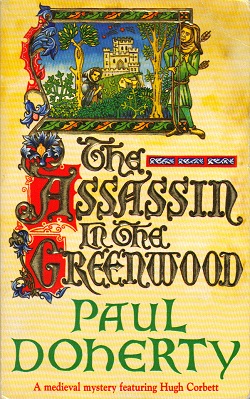 Ah, Robin Hood. Everyone knows the tales of robbing the rich and giving to the poor. Well, this is the story of robbing the rich tax-collectors, murdering all but one of them – who has his fingers cut off, just so he doesn’t feel too lucky – and there’s not much evidence of the money going back to the poor, either. Just for good measure, the Sheriff of Nottingham has been found poisoned inside his chambers – locked from the inside, of course – and with no evidence of how the poison was given to him, as everything he ate or drank was tasted first. At least we know who did it – after all, Robin has posted a ballad on the castle wall, taking responsibility for the murder.
Ah, Robin Hood. Everyone knows the tales of robbing the rich and giving to the poor. Well, this is the story of robbing the rich tax-collectors, murdering all but one of them – who has his fingers cut off, just so he doesn’t feel too lucky – and there’s not much evidence of the money going back to the poor, either. Just for good measure, the Sheriff of Nottingham has been found poisoned inside his chambers – locked from the inside, of course – and with no evidence of how the poison was given to him, as everything he ate or drank was tasted first. At least we know who did it – after all, Robin has posted a ballad on the castle wall, taking responsibility for the murder.
Sir Hugh Corbett is sent to Nottingham by Edward I to bring Robin to justice – but how exactly is one man going to bring an entire band of outlaws to justice? Edward had pardoned Robin for his earlier crimes, so why has Robin returned to an outlaw life, becoming so ruthless? How exactly did he kill the Sheriff? Who is the assassin sent by Philip of France to kill Corbett? Can Sir Guy of Gisborne be prevented from causing a massacre in the forest? And is someone playing an even grander game?
Blimey there’s a lot going on with this one. I haven’t even mentioned the French code that Corbett has to crack as well to prevent the first step in the French invasion of England, or Ranulf’s continuing, but somewhat disastrous, attempts to climb the career ladder by trying to solve the code himself. Or the fact that someone shoots three burning arrows over Nottingham Castle on the thirteenth of every month. However all of the plot points come together very nicely indeed.
The central Robin Hood mystery is very well done, and is pretty well clued. One aspect of the situation is quite guessable, but when the full picture is revealed, you will be kicking yourself because it’s pretty obvious really. I missed it totally though. I did work out the impossibility – there’s only so many ways of doing an impossible poisoning – but it’s clever enough.
If you read my last review, I was unnecessarily harsh on the book due to reading the book over the course of a number of days while being tired. I read this one directly afterwards – still tired – but knocked it off in a couple of days. That’s one of my favourite things about Dr Doherty’s work – simply put, they are bloody good reads – real page-turners – even when the mystery is a little lacking. This is certainly not the case here – a cracking mystery all round. It seems that since Doherty’s break from the series (between The Angel of Death and The Prince of Darkness), the Hugh Corbett books have been fantastic. Highly recommended.
A historical addendum: Some of you might be wondering why, as this book is set in 1302, anyone is concerned about a 100 year old outlaw – he is most commonly depicted, in films at least, fighting Prince John in the late 12th century. Well, there are historical references to Robin fighting for De Montfort against Edward I, which is the version that the author has adopted. He freely admits in his note, however, that he has interwoven many other aspects of the traditional stories into the narrative, and the result is a rather lovely compromise. I’ve always had a bit of a soft spot for Robin Hood – provided it’s on TV or in a film pre-dating Robin Hood: Prince of Thieves – and I found these aspects of the story just as enjoyable as the mystery itself.
If you want a history of the Robin Hood legend, then the Wikipedia site might be a good place to start.

I was torn what to read next, but your and Patrick’s recent review made me pick up Doherty’s The Assassins of Isis. And I have to get a copy of this book! Robin Hood and an impossible poisoning? Yes, I want!
LikeLike
[…] The Roger Shallot series had just reached The Poisoned Chalice, the Hugh Corbett series had reached The Assassin In The Greenwood and the Athelstan had just reached Murder Most Holy. All three of these are first rate examples of […]
LikeLike
[…] date, and the previous three books in the series, The Prince of Darkness, Murder Wears A Cowl and The Assassin In The Greenwood, are all excellent examples of what Doherty does best – a cracking mystery plot, some fascinating […]
LikeLike
[…] The Assassin in the Greenwood […]
LikeLike